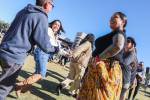Old Mormon Fort preserves birthplace of Las Vegas
The birthplace of Nevada’s largest city, the Old Las Vegas Mormon Fort State Historical Park stands just a few blocks north of Las Vegas’ busy downtown near the corner of Las Vegas Boulevard and Washington Avenue.
This attractive park preserves the oldest structure in the city, an adobe remnant of the first permanent settlement in the Las Vegas Valley built by Mormon colonizers in 1855. The park provides a quiet excursion into the past, when Las Vegas was just a welcome stopping point along a difficult and dangerous trail through the Mojave Desert to the California coast.
Open from 8 a.m. to 4:30 p.m. Tuesdays through Saturdays year-round, the Old Mormon Fort is a bargain with an entrance fee of just $1 for visitors older than 12. For information, call 702-486-3511.
From the parking area off Washington Avenue, enter through the visitor center to the re-created fort, the original adobe and grounds. Take time to enjoy the visitor center’s imaginative exhibits and browse through the books, gifts and souvenirs in the museum store. Inquire at the information desk about ranger-led tours and special events planned for this spring.
From the courtyard with its statue of early rancher Helen J. Stewart, known as “the first lady of Las Vegas,” follow paths to explore the rest of the park. The historic adobe now houses artifacts and room settings furnished in period style. The reconstruction of the fort walls creates an open parade ground used for special events, such as frontier military re-enactments. The creek that flowed through the original fort and later ranch has been re-created. The park’s plantings of native trees and vegetation attract birds and even a few desert creatures. A pioneer garden features the kinds of fruits, vegetables and flowers early settlers would have nurtured.
Settlement of the Las Vegas area began when Mormon officials in Utah sent a party of 30 missionaries from Salt Lake to the oasis called Las Vegas in late spring 1855. The group traveled 35 days on the overland route variously known as the Old Spanish Trail, the Arrowhead Trail or the Mormon Trail.
The group arrived in mid-June and immediately started to build an enclosure measuring 150 feet on each of four sides with fortified bastions on two corners. They laid out a square stone foundation and started making adobe bricks. Soon they were laying thick high walls. The colonist families were at first housed in their wagons, but soon more substantial shelters were erected against the walls. The Mormons were prepared for trouble but never had to defend themselves.
The enterprising group also started various crops irrigated by creek water from large warm springs. They planted fruit trees, seeded vegetable gardens and pastured their livestock in the natural meadows. By late summer they were harvesting food. Scouting parties located resources such as timber and minerals in the mountains surrounding the valley. They began mining lead deposits in the Potosi area and started the process of smelting the ore. After two years of laboring, they were recalled to Utah, leaving the fort abandoned.
The property was acquired in 1865 by Octavius Gass, a miner in Eldorado Canyon along the Colorado River. Gass developed the property into a ranch, building house and outbuildings using materials scavenged from the fort. He made a living from livestock and services provided to miners and travelers on the trail.
In 1881, Gass defaulted on a large loan, losing the ranch to Archibald and Helen Stewart, who continued ranching and raising their young family near the old fort. In 1884, when Archibald was murdered at a neighboring ranch, Helen was left to continue running the Las Vegas Ranch.
With the help of her father and local Paiutes, she successfully carried on the enterprise until 1902 when she sold the acreage to the San Pedro, Salt Lake City and Los Angeles Railroad (later known as the Union Pacific). The railroad reached the valley in 1905, creating the city of Las Vegas with the auction of lots in the downtown area. Helen J. Stewart remained a prominent citizen of the emerging town, encouraging polite society and civilizing elements such as women’s clubs, schools and churches.
Margo Bartlett Pesek’s Trip of the Week column appears on Sundays.




























